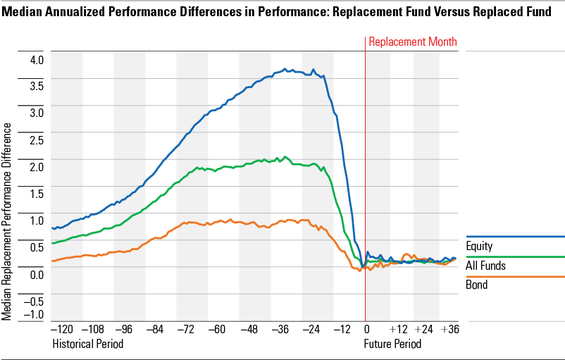Managing U.S. retirement investments is no small feat: As of March 2019, U.S. workers had about $5.7 trillion invested in 401(k) plans. As retirement plan fiduciaries, plan sponsors and plan advisors have a responsibility to select and monitor these investments while acting in the participant’s best interests. And when it comes to helping retirement savers meet their retirement goals, paying attention to the performance of these investments can be crucial.
This retirement plan fiduciary responsibility may mean occasionally deciding to add, remove, or swap investments. There has been some research suggesting that these types of changes—especially poorly timed ones—may reduce value and negatively impact investors, but overall, little is known about whether switching investment options is valuable for retirement savers.
To better understand the effects of changing investments, we studied more than 3,000 fund replacements, which occurred between January 2010 and November 2018, across 678 plans. To help ensure we were comparing apples to apples, we only looked at instances where the replacement and replaced funds existed in the same Morningstar Category.
Although more in-depth research in this area is warranted, our research suggested that replacing funds has the potential to improve outcomes for retirement investors (even after controlling for various fund characteristics and risk factors). Learn more about these findings below.
Replacement funds were more attractive in a number of areas
Unsurprisingly, at the time of the replacement, the new funds tended to have attributes that were more “attractive” than the funds they replaced. These attributes included better historical performance, lower expense ratios, and more favorable Morningstar Ratings™ and Morningstar Quantitative Ratings™ for funds.*
Replacement funds outperformed the funds they replaced
Our study found that the replacement funds outperformed the replaced funds over both one- and three-year periods following the replacement.
As shown on the chart below, the difference in performance quality was greatest about 36 months before the replacement and dwindled down to almost nonexistent by the time the fund was replaced. However, the chart also shows that outperformance increased again after the replacement date and continued to grow over the next three years.

Source: Morningstar Direct and author’s calculations. Data as of November 2018. For illustrative purposes only.
Our research also showed that this difference in performance couldn’t be explained by differences in other factors, such as expenses or investment approach. This suggests that by keeping a watchful eye and changing out weaker funds, plan sponsors have the potential to improve investment performance and participants’ retirement outcomes.
The important role of retirement plan fiduciaries
Though offering an effective investment menu can be crucial to retirement savers, choosing and monitoring plan investments isn’t easy. Poor, ineffective menus can be detrimental to both participants and plan sponsors, so many sponsors opt to delegate this responsibility to a third party. Across plans, the responsibility for creating the menu can either be shared or completely outsourced to a hired investment manager.
No matter the arrangement, retirement plan fiduciaries are responsible for keeping a watchful eye on investment options—which, this study suggests, can lead to better outcomes for participants.
David Blanchett is a retirement researcher for Morningstar Investment Management and Jim Licato is a product manager for the Morningstar Retirement Solutions product group.

